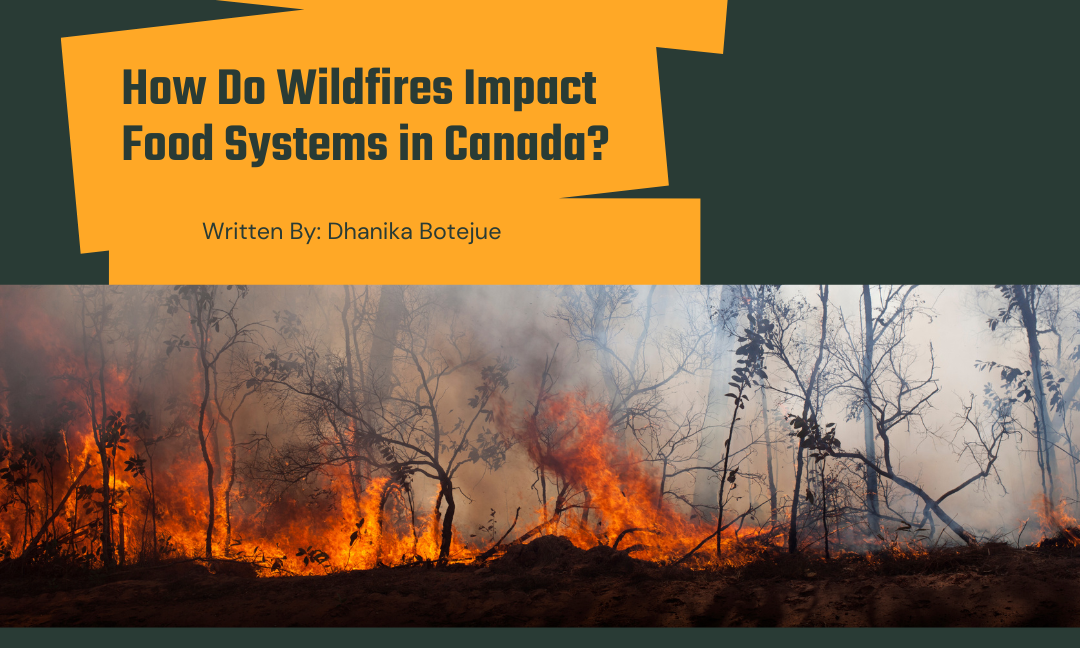Written by: Dhanika Botejue
Edited by: Astha Patel
Designed by: Eshika Hiremath
Published by: Maryam Khan
Wildfires are untamable fires that burn in vegetation, often causing devastating effects on the environment. Research has shown that over 50%  of wildfires are started by the carelessness of humans. However, 67% of the land burned by wildfires is from the after-effects of lightning. Lightning often strikes in remote areas, making the fires increasingly harder to suppress, which causes more land degradation.
of wildfires are started by the carelessness of humans. However, 67% of the land burned by wildfires is from the after-effects of lightning. Lightning often strikes in remote areas, making the fires increasingly harder to suppress, which causes more land degradation.
While a wildfire is ongoing, smoke covers large areas, almost preventing crops from having access to sunlight. The reduction of sunlight, essential for photosynthesis, forces crops to struggle to photosynthesize effectively. This struggle leads to stunted growth, smaller yields, and less nutritional value. Although, the effects are unique for each species. For example, if smoke blankets are covering corn, it may cause the corn to rot. Tests have shown that with potatoes, growth will be stunted and there will be a disruption in quality prediction.
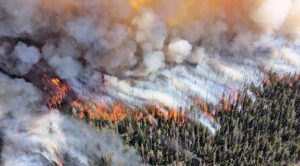 Experts watch hundreds of animal species to ensure their safety from the many wildfires burning through Ontarian forests. Scientists have found that animals are changing to try to survive wildfires. For example, some animals find water, and others escape the fire. As the warmer months increase in heat and humidity, fires are becoming more common. Additionally, these fires have become vaster, hotter, and scaled to a higher intensity. Some researchers fear that due to climate change, wildfires will evolve to a point where animals’ adaptations will not be able to save them.
Experts watch hundreds of animal species to ensure their safety from the many wildfires burning through Ontarian forests. Scientists have found that animals are changing to try to survive wildfires. For example, some animals find water, and others escape the fire. As the warmer months increase in heat and humidity, fires are becoming more common. Additionally, these fires have become vaster, hotter, and scaled to a higher intensity. Some researchers fear that due to climate change, wildfires will evolve to a point where animals’ adaptations will not be able to save them.
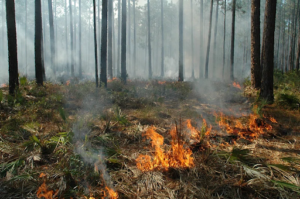 Wildfires have caused greenhouse power outages because they ruined harvesting equipment and destroyed numerous electrical lines, resulting in crop death. In addition, the smoke created by these fires forces pollinating insects to leave farms, resulting in lesser fruit production. These ferocious fires force some farmers to leave their ranches because of the safety protocols. Their mandatory evacuations then result in lower yields and in some cases crop death. Other farmers face dangerous smoke conditions that prevent them from going outside to fertilize or irrigate their crops.
Wildfires have caused greenhouse power outages because they ruined harvesting equipment and destroyed numerous electrical lines, resulting in crop death. In addition, the smoke created by these fires forces pollinating insects to leave farms, resulting in lesser fruit production. These ferocious fires force some farmers to leave their ranches because of the safety protocols. Their mandatory evacuations then result in lower yields and in some cases crop death. Other farmers face dangerous smoke conditions that prevent them from going outside to fertilize or irrigate their crops.
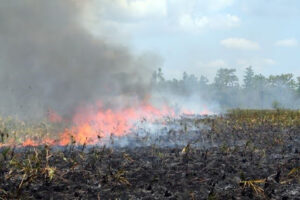 Approximately 2.48 million hectares of land have been burned in British Columbia since April 1, 2023.
Approximately 2.48 million hectares of land have been burned in British Columbia since April 1, 2023.
The founder of Working Group on Indigenous Food Sovereignty, (WGIFS is a group that preserves Indigenous food systems and knowledge.) Dawn Morris, stated that more than 40,000 hectares of the hectares scorched were traditional harvesting areas. The equipment of the WGIFS, such as their supplies and storage, were wrecked because of a wildfire. A member of the WGIFS had their home destroyed by one of these monsters, causing some materials he had to be obliterated. One of these fires also burned an indigenous hunter of the WGIFS’s winches, pressure canners, cooking grills, and several freezers containing bison, elk, and salmon meat. These fires negatively affected this organization and community.
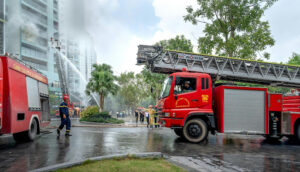 The government invests money in initiatives supporting wildfire prevention to stop these fires from destroying food systems. Since 2019, the Canadian government has invested over one billion dollars into these endeavors. Although many wildfires are ongoing today, the Government of Canada has helped stop and suppress a considerable amount of these fires, which were initially detrimental to food systems.
The government invests money in initiatives supporting wildfire prevention to stop these fires from destroying food systems. Since 2019, the Canadian government has invested over one billion dollars into these endeavors. Although many wildfires are ongoing today, the Government of Canada has helped stop and suppress a considerable amount of these fires, which were initially detrimental to food systems.
Websites:
Forest fires, wildfires, Forests Ontario, Canada, Forest Recovery Canada
GLOBE-Net How Will Canadian Wildfires Impact Crop Production
Raging Canada wildfires threaten critical infrastructure, force evacuations | Reuters
Keeping Canadians safe from wildfires | Prime Minister of Canada
Cost of wildland fire protection

